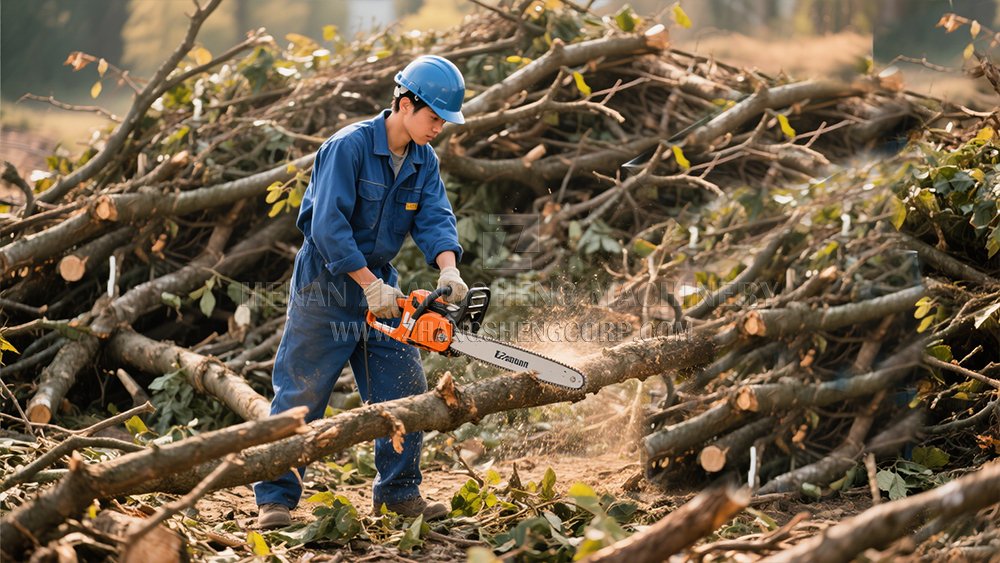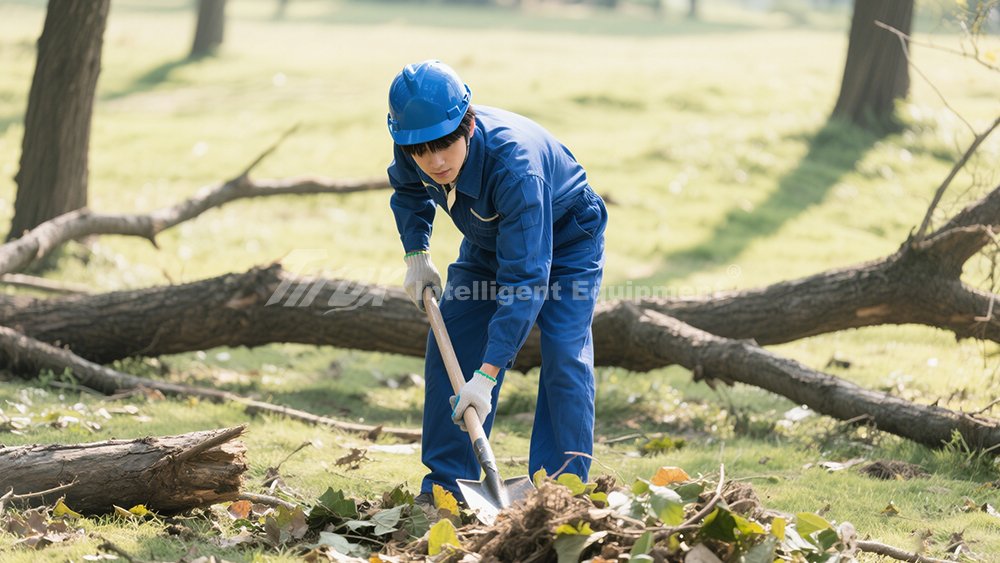Your yard is covered in leaves, and you are wondering if your wood chipper can handle them. It seems like an easy answer, but is it a good idea for your machine?
Generally, you can put a small amount of leaves into a wood chipper, especially if they are mixed with branches. But putting in large amounts of loose, wet leaves is not a good idea. This can make the machine jam and work less well.
As a manufacturer with 22 years of experience at Zhangsheng, I have seen many customers try to use their wood chippers for everything. While our machines are strong, knowing what they are best for is key to making them last and work well. Let us look closer at this.
What not to put in a wood chipper?
You have a lot of waste to process. Your chipper seems perfect for it. But are there things you should never put inside? Putting the wrong materials in can cause serious problems for your machine and even for you.
You should never put metal, rocks, glass, plastic, rubber, very wet or muddy material, large stumps with many roots, or long vines and ropes into a wood chipper. These items can break the blades, clog the machine, or be dangerous.
I remember a time when a customer, a construction and demolition company [B2B Target Customer: Construction & Demolition Companies], tried to chip some mixed debris. They accidentally fed in a piece of metal rebar. It immediately damaged the blades and the main rotor. Even with our "Made in China + International Quality" machines, which are built very strong, metal is a definite no-go. Rocks and dirt are also very bad. They are abrasive. This means they act like sandpaper and wear down the blades very quickly, making them dull. If a large rock gets in, it can chip or break a blade instantly. Glass and plastic might seem light, but they do not break down like wood. They can shatter into sharp pieces, which is very dangerous. They can also melt or wrap around internal parts. Rubber, like old tires or hoses, can wrap around the rotor or shafts. This causes major clogs and can damage the machine's engine or hydraulic system. Very wet or muddy material is also a problem. It can turn into a paste inside the chipper, making it hard to clean and causing clogs. Large stumps with too many roots are usually too big and tough for regular chippers. Our specialized horizontal grinders might handle them, but standard chippers often struggle. Lastly, long, stringy items like vines, ropes, or even fabric can tangle around the rotor and feed rollers. This quickly jams the machine and can stop it completely. Knowing these limits is important for safety and for keeping your Zhangsheng chipper working for a long time.

Items You Should Never Put In a Wood Chipper
| Item | Why You Should Not Put It In | Possible Damage or Problem |
|---|---|---|
| Metal | Very hard and does not break down. | Breaks or chips blades, damages rotor, can cause sparks or fire. |
| Rocks, Sand, Dirt | Very abrasive. | Makes blades dull very fast, can chip blades. |
| Glass | Shatters into dangerous pieces. | Damages blades, creates sharp debris, risk of injury. |
| Plastic/Rubber | Does not chip, can melt, wraps around parts. | Clogs machine, damages internal components, fire risk. |
| Very Wet or Muddy Material | Creates a thick paste inside. | Clogs feed, reduces efficiency, hard to clean, promotes rust. |
| Large Stumps with Roots | Often too big and strong for chipper's power. | Overstresses engine, jams, can damage rotor or feed mechanism. |
| Long Vines/Ropes/Fabric | Can wrap tightly around shafts and rollers. | Causes severe clogs, stops machine, damages bearings or engine. |
By avoiding these items, you help protect your investment and keep your Zhangsheng chipper safe to use.
What is the difference between a leaf mulcher and a wood chipper?
You have heard about leaf mulchers and wood chippers. They sound similar. But they are made for different jobs. Knowing the difference will help you pick the right tool for what you need to do.
A leaf mulcher is made to finely shred soft materials like leaves, small twigs, and garden waste. A wood chipper, on the other hand, is built to process harder, larger wood, such as branches and logs, into chips.
At Zhangsheng, we focus on wood chippers because our B2B customers, like forestry companies [B2B Target Customer: Forestry & Logging Companies] or sawmills [B2B Target Customer: Sawmills & Wood Processing Plants], need to process real wood. The main difference is in their design and purpose. A leaf mulcher often uses hammer flails or a series of rotating blades designed to tear and shred soft materials. Its power is usually lower, and its opening size is much smaller, meant for thin, flexible waste. The output is a fine, often fluffy mulch, good for composting or garden beds. A wood chipper, however, uses heavy-duty, sharp knives (blades) mounted on a rotating disc or drum. These blades slice through solid wood. The engine on a wood chipper is much more powerful, often diesel, to handle tough, dense wood. The feed opening is also much larger, allowing for thick branches or even whole logs, especially on our industrial horizontal grinders. The output of a chipper is typically larger, more uniform wood chips. These chips are good for biomass fuel, landscaping mulch, or pulp. For a large farm [B2B Target Customer: Large Farms & Plantation Owners] or a landscaping company [B2B Target Customer: Landscaping & Tree Care Companies], understanding which machine handles their specific waste is crucial. Our Zhangsheng wood chippers are made for the tough stuff, not delicate leaf processing, ensuring "Technological Leadership" in heavy-duty wood recycling.
Main Differences: Leaf Mulcher vs. Wood Chipper
| Feature | Wood Chipper | Leaf Mulcher |
|---|---|---|
| Main Purpose | Processing hard branches and logs into chips. | Shredding leaves, small twigs, and soft garden waste. |
| Cutting Method | Heavy-duty, sharp knives (blades) on a disk or drum that slice. | Hammer flails or small, tearing blades that shred and tear. |
| Power | High power, often diesel engines. | Lower power, often electric or small gas engines. |
| Feed Opening | Large, designed for thick branches and logs. | Small, designed for loose leaves and thin twigs. |
| Output | Uniform wood chips (larger, coarser). | Fine, fluffy mulch or shredded debris. |
| Ideal Materials | Branches, logs, woody brush, construction wood waste. | Leaves, small green twigs, garden clippings, soft plant debris. |
Choosing the right machine for your waste type ensures efficiency and avoids machine damage.
Can you put dried branches in a wood chipper?
You have a pile of dried-out branches from pruning last season. They are hard and brittle. Can your wood chipper handle them, or should you be careful?
Yes, you can generally put dried branches into a wood chipper. In fact, dry wood often processes more efficiently and produces cleaner, more uniform chips than green wood. But, very old or extremely brittle wood might splinter more.

I often tell forestry and logging companies [B2B Target Customer: Forestry & Logging Companies] that processing dry material can be more efficient for chippers. Our horizontally tracked grinders, for example, excel at handling larger, tougher, often drier logs and branches right in the field. When wood is green, it contains a lot of moisture. This moisture can sometimes make the blades work harder, and the chips might be stringy or wet. Dry wood, on the other hand, is less dense because the water has left. This allows the chipper blades to cut through it more cleanly, resulting in crisp, uniform chips. This also often puts less strain on the chipper's engine, potentially saving fuel. However, there are some things to watch out for. Extremely old or very brittle dry wood can sometimes shatter or splinter in unpredictable ways. This can lead to more dust being produced during chipping. It can also mean that some pieces might be less uniform than you expect. Also, if the wood has been lying on the ground for a long time, it might have picked up dirt or small stones. As I mentioned before, any foreign material is bad for the blades. So, always check the branches for embedded debris before feeding them. Generally, dry wood is preferable for chipping. It means a smoother process for your machine and a better quality end product. This is part of the "Worry-Free Global After-Sales" advice we give, making sure customers use their machines in the best way.
Processing Dried Branches: Pros and Cons
| Aspect | Advantages of Chipping Dry Branches | Potential Challenges |
|---|---|---|
| Chipping Efficiency | Easier for blades to cut, less strain on engine. | Very old/brittle wood can shatter, creating more dust. |
| Chip Quality | Cleaner, more uniform, drier chips, ideal for biomass or mulch. | Chips might be smaller or more fragmented if wood is very brittle. |
| Blade Wear | Generally less strain from moisture, but can increase if wood is very hard and dry. | Watch for embedded dirt/stones that increase wear significantly. |
| Machine Performance | Smoother operation, potentially lower fuel consumption. | Higher dust output, requiring more attention to air filters. |
Using dry wood can often improve chipper performance, but always check for contaminants.
Conclusion
You can put leaves in a chipper if mixed with branches, but avoid large, wet piles. Never put metal or rocks in. Remember, a chipper processes wood, while a mulcher handles soft materials. Dry branches chip well.


